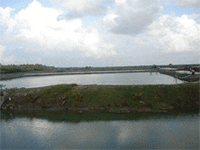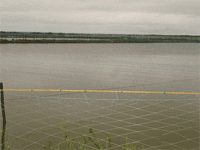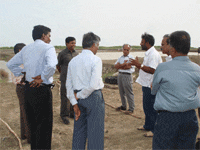In India shrimp aquaculture is being practised mostly along the brackish water creeks and canals in clusters of farms drawing and draining water from the same source.
There are around 100,000 small-scale shrimp farmers occupying about 140,000 hectares with an annual production of about 140,000 tonnes1. Indian shrimp culture has passed through three distinct phases.
The 'rising phase-I' from the late eighties to 1995 wherein a sense of competitiveness prevailed among the farmers in a given locality. The farmers maintained ‘at most secrecy’ in all farm operations to produce more shrimp and make huge profits in just about four months of grow-out.

The ‘falling phase-II’ (1995-2001) witnessed the emergence of virulent viral diseases, particularly the ‘White Spot Syndrome Virus’ (WSSV), which reduced the shrimp aquaculture industry to chaos, mainly due to greed for high production, ‘self pollution’ due to poor farm management and lack of experience and cooperation among the shrimp farmers. Nevertheless, as a blessing in disguise this disaster made the shrimp farming a self mature and more responsible farming regime despite colossal losses and legal interventions at the time.
The ‘sustainable phase-III’ (since 2002) facilitated with interventions from research and development institutions encouraged farmers to be open to their fellow farmers and to understand that one’s success was dependent on his neighbour’s success, also. This realisation led to the formation of cluster based farmer groups to enforce certain code of practices collectively adopted by the farmers. Further to this, market forces (price and food safety), anti-shrimp farming campaigns, legal and other socio-economic threats have also strongly contributed towards the development of group approach in shrimp farm clusters.
Experience has amply shown that farmer groups can ensure responsible and sustainable aquaculture development2,3, empower farmers through collective decision making4,5,6, offer opportunities to link with markets, improve social, environmental and food safety responsibility6, facilitate delivery of farm extension services and contribute to the long-term sustainability of the shrimp farming7,8,9,10.

Pamini River Shrimp Cluster: a Success Story of the Group Approach
The primary advantage of group approach to shrimp farming is that it enables participating farmers to organise the schedule of farm operations, quality seed procurement, simultaneous stocking, water exchange and harvesting regimes contributing to substantial reduction in the vertical and intra cluster transmission of disease.
In this context, the Pamini River Shrimp Farmers Association in Tiruvarur district of coastal Tamil Nadu (South India), a self-initiated dynamic cluster-based association, was studied using case study methodology to determine its role in the sustainability of shrimp farming in the area. Popularly known as DCM cluster (land owned by M/s. DCM textile company and later sold to the local villagers), this association was formed by the farmers themselves in the year 2003, mainly to prevent and manage the disease outbreaks collectively by enforcing better management practices.
The cluster started with just five farms (35 ponds) in 2003 and has now grown to 50 farms (320 ponds). One season of shrimp culture (February - July) was practiced in this cluster. The association oversaw the farm operations including pond preparation, stocking, farm management, harvesting and marketing to prevent the vertical and horizontal transmission of disease, promote optimum utilisation of resources and to help farmers get a better price for their shrimp their crop.
Planning, Seed Procurement and Stocking
The association planned shrimp farming activities through a General Body meeting in which the farming calendar and better management practices, including the bio-security measures to be followed (Table 1), were decided as a written document endorsed by all the farmers.
| Table 1. Better management practices adopted by the group | |||||
|---|---|---|---|---|---|
| Prevention of vertical transmission of diseases | Prevention of horizontal transmission of diseases - pathogen transfer | Prevention of stress to shrimp | Ensuring food safety | Ensuring environmental safety | Ensuring economic stability |
| 1. Selection of brooders 2. Selection of seed from single spawning 3. Selection of seeds from single mother shrimp 4. Quality seed-colour, activity, uniform size, muscle:gut ratio, length, MBV & PCR tests 5. Optimum seed packing density 6. On-farm nursery |
1. Initial chlorination of pond water 2. Filtration of inlet water to prevent vectors 3. Reservoir-chlorination-water to prevent vectors 4. Crop scheduling 5. Synchronised stocking 6. Restriction of movements of people, equipment etc 7. Disinfection of people, equipment, vehicles 8. Bird scaring & crab fencing 9. Remove & bury moribund/dead shrimps 10. No draining of disease-infected pond water 11. Emergency harvest & bleaching of disease-affected pond 12. Disease attack-information to nearby farmers |
1. Removal of bottom black soil & drying, ploughing etc 2. Drying & ploughing to remove bottom algae, gastropods 3. Acclimatisation of seed before stocking 4. Maintenance of optimum soil, water quality parameters (pH, salinity, temperature, bloom, oxygen, bottom soil) 5. Feeding & feed management - type of feed, rationing, scheduling, method & place of feeding 6. Aerators-position & orientation 7. Maintenance of optimum blooming & water depth in ponds 8. Removal of floating algae & weeds 9. Appropriate water exchange-reservoir 10. Chain dragging of pond 11. Prevention of development of benthic algae 12. Monitor soil & water quality & animal behaviour 13. Avoidance of feeding shrimp with the by-catch crustaceans |
1. Sites free from industrial pollution-preventing residual heavy metals 2. Non-use of harmful/banned drugs, pesticides, antibiotics 3. Appropriate harvesting time/method 4. Avoidance of feeding shrimps 6 hours prior to harvest to keep the gut empty to improve shelf life 5. Thoroughly wash the hand-picked shrimps in clean water & pack them separately to maintain quality 6. Dipping of harvested shrimps in freshwater ice slurry for freshness & additional weight 7. Avoidance of use of any chemicals during washing & chilling harvested shrimp 8. Packing harvested shrimps in tubs with ice 1:1 ratio for better preservation 9. Maintain cleanliness while packing & stacking 10. Separate any dead or discoloured shrimp from the quality shrimp |
1. Proper site selection-guidelines 2. Shrimp farm-minimum distance from human settlements 3. Farming does not affect other traditional activities 4. WSA 60:40 for other purposes 5. Separate inlet & outlet on each farm 6. Mangrove plantations in the bunds to prevent erosion 7. Non-use of bore well water |
1. Written agreement 2. Loss compensation 3. Risk coverage 4. Quality assurance to buyers |
The association monitored the farming operations in the cluster by appointing a technical person who facilitated proper pond preparation, initial water intake, double filtration and chlorination in the ponds. It constituted a seed team for seed procurement from one reputed hatchery and the team monitored the complete seed production process.
Seed selection included screening of broodstock, nauplii, early and later stages of post larvae (PL 5 and PL 15–20) at the time of purchase in more than one diagnostic laboratory. Seed were procured collectively or individually from the same hatchery. When seed were purchased by a group, the seed requirement of the individual members were calculated and packed separately. Even in the case of individual purchase, the hatchery was asked to furnish the details of seed taken by every individual farmer. This measure ensured that there was no variation in the stocking density among the member farms. It was mandatory to submit a copy of the report to the association that seeds have been subjected to the PCR screening.
The association decided that the stocking was done in a period of 20 days and the stocking density was kept less than six PL per square metre. Collective seed procurement reduced the seed cost due to the nature of bulk order procurement and the low unit incidental and transport expenses. Moreover, there was a plan to raise ‘seed money’ from the common fund raised to supply ‘free seed’ to farmers for the next culture.
Pond Management
It was mandatory that every pond was bird fenced and non-compliance attracted penalty of 2,000 rupees (INR) per pond (US$40). It was reported that bird fencing had reduced the disease spread by 30 to 40 per cent. Every farm had a reservoir wherein the source water was disinfected and used for water exchange. Every farm had a paid consultant who visited the farm once a week to monitor and advice. The following practices in farm management were strictly followed:
- Feed rationing and scheduling based initially on feed off-take from the check tray up to 60 days and then based on check tray and weekly sampling till harvesting.
- Soil and water quality management through application of probiotics, adequate aeration and continuous monitoring of animal behaviour.
The association permitted only a few well-known consultants to advise the farmers. The consultants were asked to appraise the association about the farm conditions of their clients. Movement of people were strictly restricted if there were disease incidences in the nearby areas. Consultants alone were permitted to move in the restricted areas after disinfection and as a precautionary measure, feed tray checking was not allowed during that time. Use of antibiotics was banned. However, use of probiotics and sanitizers were encouraged during the culture period.

Collective Disease Management
In spite of all precautions, if an outbreak of the disease occurred it was immediately informed to the association. The association convened an emergency meeting and decided the course of action. There were two courses of action:
- either premature harvest was resorted to or
- the pond was bleached.
Depending on the DOC (day of culture), nature and magnitude of problem, an appropriate decision was taken. Disease affected ponds were bleached if the culture was in less than 60 DOC. Bleaching of ponds was continued in a certain number of ponds to carry forward the culture in the other ponds to the maximum possible period. During such occasions the association assured the affected farmers’ in writing that they would be compensated. The cost of bleaching was borne by the association.
In 2007, when there was a disease attack in this cluster, the association bleached about 20 ponds and a sum of INR2 million (approximately US$50,000) was paid as compensation to 20 ponds. Premature or emergency harvesting was also allowed if the disease was other than WSSV. Even in the event of an outbreak of WSSV, if the shrimp were heavier than 15g, with due precautionary measures the ponds were safely harvested using drag nets without letting out the pond water.
Compensation to the Affected Farmers through Facilitated Marketing
The association invited quotations from shrimp buyers for negotiating the best price for the shrimp produced in the cluster. However, the price was not binding on the members. Irrespective of the buyer, a stamped agreement (legally enforceable) was signed and given to the association by the farmers and the chosen buyers. This agreement stated that a given amount of the sale price per kg of shrimp sold was to be deducted at the buyer’s end and handed over to the association to compensate the affected farmers and for maintaining the common facilities. It was the responsibility of the buyer to ensure this payment to the association. The same procedure was adopted to collect the common fund for the association to take up collective works even in normal culture seasons. This amount was deposited in the bank as a joint account operated by three executive members to ensure its safety and make certain that the agreed compensation was paid to the farmers who lost their crop due to the disease.

Group Management of Operation
All the farmers in the cluster were members of the association and they owned it. The association had written bylaws but was not a registered body. The association had a President, Secretary and a Treasurer. They were nominated unanimously and these positions were honorary. While the General Body meeting was the first one in which most of the members participated and the subsequent meetings were organised only whenever required during the culture period. In the first meeting prior to beginning of culture operations, the do’s and don’ts were discussed, recorded as minutes and signed by all the farmers. The issues were discussed, sorted out collectively by consensus and the decisions were fully complied. The association had dynamic leaders to carry forward its activities taking the members together in confidence.
The association was socially cohesive and successful since most of the members belonged to the same village and community. Mutual trust and commitment prevailed among the members as is evident from the consent given for crop bleaching on the event of full scale disease outbreaks and compensation agreed upon. The association adjudicated the conflicts if any between the members amicably. It had also kept proper financial records officially audited every year.
Interaction with Key Stakeholders and Social Responsibility
The Association was authorised to negotiate with hatcheries and shrimp buyers for quality seed and price respectively. Public institutions and private input traders considered the association as the representative of the farming community. It had closer interactions with the neighbouring farmers and shared information for mutual benefit. Since most of the farmers belonged to the same or nearby villages, cordial relations were maintained with everybody. The associations helped the village in developing and maintaining infrastructures, like roads, school buildings, temple renovation etc., for the benefit of the villages and fishers. Moreover, local villagers and fishers were given employment in shrimp farms. The group maintained close rapport and linkage with government departments and facilitated through the Department of Fisheries for availing farming approval from the Coastal Aquaculture Authority (CAA), which is mandatory for setting up aquaculture farms.
Since formation of the Pamini River Shrimp Farmers Association in 2003 all the crops were successful barring 2007. The association attributed its triumph to the factors indicated in Table 1.
Conclusion
This association has been organising shrimp farming collectively contributing to the sustainability of the production system as well as farmers’ welfare.
Information sharing and close interactive approaches among farmers in shrimp farming cluster were the rules of the game.
The compensation linked shrimp disease management is a unique mechanism to be emulated by other shrimp farming clusters.
The association was contemplating to procure inputs like feed collectively by negotiating with the feed producer. However, this needs either credit support or a facilitating mechanism like contract farming from the institutional credit agencies.
This group need to be facilitated to explore the possibility of ‘branding’ the quality shrimps produced and obtaining geographical indication from appropriate agencies, like the ‘Mahagrapes’ by grape farmers of Maharashtra in India.
It is suggested that since the association controls every practice from seed to shrimp, the CAA could consider this cluster as single farm and give one approval as a whole in the name of the association subject to the adherence of its regulations. Such recognition would help the cluster to receive certification from national and international aquaculture agencies as a producer of safe and quality shrimp.
Acknowledgement
The author expresses his sincere thanks to M. Krishnan, V.S. Chandrasekaran, Principal Scientists and T. Ravisankar and K. Ponnusamy, Senior Scientists, Social Sciences Division, CIBA for their critical review and inputs. The author also expresses his gratefulness to A.G. Ponniah, the Director, CIBA for his continued encouragement and support.
References
MPEDA. (2008). MPEDA Annual Report. Kumaran. M, Kalaimani. N, Ponnusamy. K, Chandrasekaran. V.S and Vimala, D.D. (2003). A case of informal shrimp farmers Association and its role in sustainable shrimp farming in Tamil Nadu, India. Aquaculture Asia, VIII (2): 10-12. Kutty, M.N., Ravichandran, P., Krishnan, M., Kumaran, M. and Balasubramanian, C.P. (2003). Case Studies in India on the Role of Small Farmer Groups and Associations in Sustainable Shrimp Aquaculture Management. Report prepared under the World Bank, NACA, WWF and FAO Consortium Program on Shrimp Farming and the Environment, 120 pp. Davis, K. (2006). Institutional Arrangements for Increasing the Dissemination Role of Farmer Groups in Agricultural Innovation Systems – journal of International Association of Extension Education, p152–162. Marine Products Export Development Authority (2006). Action Plan for Development of export oriented aquaculture in maritime states of India. Prepared and published by the MPEDA, Cochin, India, 72 pp. Umesh, N.R. (2008). Sustainable aquaculture through empowerment of farmers. Paper presented in the Aqua India-2008, February, 2009, Organised by Society of Aquaculture professionals, Chennai, India. Krishna. S, Sridhar., M, Kartha, P.N.R and Mohanan, A.N. (2000). Group farming for Sustainable Aquaculture, Ocean and Coastal Management, 43: 557-571. Franzel, S., Wambugu, C. and Tuwei, P. (2003). The adoption and dissemination of fodder shrubs in central Kenya. AgREN Network Paper No. 131. London, UK: The Overseas Development Institute. Omoyeni, B.A. and Yisa, J. (2005). Enhancement of fish production in Borno State with extension services: In Araoye, P.A. (ed.,) Proceedings of the Annual Conference of the Fisheries Society of Nigeria (FISON). p658-662. Kumaran. M. (2007). Participatory Technology Transfer Model for Sustainable Coastal Aquaculture, Final Report of the AP Cess funded project, Social Sciences Division, CIBA, Chennai, Report, 136 pp.This article was published in Aquaculture Asia Magazine
October 2009



